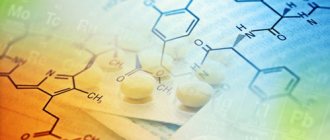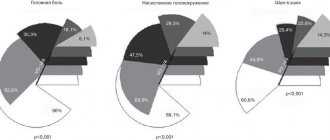Normotimics (normotimic drugs, mood stabilizers, thymoisoleptics) are a group of drugs that have different mechanisms of action and pharmacological properties, but the general purpose of their use is considered to be normalization of mood.
Thymoisoleptics are prescribed for the purpose of treating and eliminating affective disorders (mood stabilization), as well as reducing the risk of relapses.
The list of drugs that can be classified as mood stabilizers, and which are widely used at this stage of development of medicine, is not so long; the following are used for medicinal purposes:
- lithium salts;
- Carbazepine and its derivatives;
- valproates;
- Lamotrigine.
When using this group of drugs, there must be strict medical control over the patient’s condition, it is necessary to control the concentration of active substances in the blood.
You should not abruptly stop taking thymoisoleptics, as this is fraught with a resumption of affective states. The medication must be discontinued for several weeks.
Indications and purposes of use
An indication for the use of mood stabilizers is the presence within three years of two or more attacks of exacerbation of an affective or affective-delusional state within the categories listed below:
- schizoaffective disorder;
- bipolar affective state;
- long-term recurrent depression;
- chronic mood disorder;
- cyclothymia.
Regulatory drugs have the following properties:
- eliminate serious causes;
- relieve irritability;
- stop short temper;
- eliminate impulsiveness;
- relieve symptoms of dysphoria in patients with mental disorders.
List of used literature
1. Mazo G.E. “Normotimiki in the treatment of treatment-resistant depression: anti-resistant therapy or influence on latent bipolarity?”
2. Marilov V.V., Sologub M.B. “Comparative effectiveness of mood stabilizers in complex therapy of bulimia nervosa.”
3. Malin D.I. "Drug interactions of drugs used in psychiatric practice."
4. Aleksandrovsky Yu.A. "Rational pharmacotherapy in psychiatric practice: a guide for practitioners."
5. Maslov K.A. “Normotimiki in Russia in modern clinical practice of a psychiatrist.”
6. Arana D., Rosenbaum D.F. "Guide to psychopharmacotherapy."
7. Amir O. “Normotimiki.”
Share
Share
Therapeutic effect
Normotimics are prescribed for the treatment of affective states and for the purpose of prevention in case of minor relapses of affective psychoses. Most of this group of drugs are considered anticonvulsants.
Thymoisoleptics are now increasingly used to improve mood. Initially, they were used only in the treatment of epilepsy to relieve seizures. Further, this group of drugs began to be used to treat affective states, long-term depression, to equalize and stabilize mood and reduce sharp edges during communication when the patient has a difficult temperament.
Long-term treatment helps reduce the risk of relapse while normalizing mood swings.
Mechanism and features of the effect
There is no reliable data on how mood stabilizers work. Based on the research conducted so far, the following results were obtained:
- the main cellular mechanisms that are triggered under the influence of thymoisoleptics have been identified;
- lithium reduces neuronal signal transmission, thereby increasing mood;
- the concentration of adenylate and cyclase is suppressed;
- The main task of this group of drugs is to stabilize mood and eliminate the causes of the affective state.
Features and precautions for use
Treatment with mood stabilizers should be carried out under the strict supervision of medical personnel and the concentration of the active substance in the blood should be regularly checked. If its content is increased, the side effects of mood stabilizers may worsen.
Medicines in this group should be used with caution if the patient has a history of:
- disturbance of heart rhythm and conduction;
- severe pathology of the liver and kidneys;
- blood and bone marrow diseases;
- predisposition to allergies;
- prostatitis;
- drugs are contraindicated during pregnancy and breastfeeding;
- hypersensitivity to drug components;
- acute pancreatitis;
- at reduced pressure.
With long-term treatment with mood stabilizers, you need to:
- monitor the general condition of the patient;
- once a month donate blood for biochemistry, clinical blood and urine tests;
- ECG.
What is obsessional neurosis, and does it need to be treated?
The main goal of treatment is to maximize the patient’s quality of life. If a disease interferes with life, then it definitely needs to be treated. Does obsessional neurosis interfere with normal life? To understand this, you need to find out what is commonly understood by this term.
Obsession is the appearance in a person of thoughts or actions that are perceived by him as something alien. A person cannot get rid of them: obsessions force him to perform certain actions, thereby becoming the cause of debilitating mental discomfort.
Lithium salts
Indications for use:
- hereditary predisposition to affective disorders;
- slight severity of negative symptoms;
- a clear picture of an attack;
- bipolar form of affective disorder;
- manic syndrome;
- rhythm throughout the day.
For a long time, this group of drugs has been prescribed to eliminate the above conditions. The drugs are used to treat and prevent diseases.
Lithium preparations have been studied quite well and provide a positive therapeutic effect. During the period of taking lithium salts, it is necessary to maintain strict medical control and monitor the concentration of the drug in the blood. If its content is significant, side effects from taking the drug may increase.
Side effects:
- hand tremors;
- thirst;
- muscle weakness;
- drowsiness;
- nausea.
The main forms of eating disorders are anorexia nervosa and bulimia nervosa. There is evidence in the literature of an increase in the number of patients with this pathology [7-9, 11] over the last decade.
According to ICD-10, for a reliable diagnosis of bulimia nervosa, the presence of the following signs is required: a) constant preoccupation with food and irresistible cravings for food, when the patient periodically cannot resist overeating and takes a large amount of food in a short time; b) counteracting the effect of obesity from the food eaten by the patient using one or more techniques: inducing vomiting; laxative abuse, alternative fasting periods; use of appetite suppressants, thyroid medications, or diuretics; neglect of insulin therapy by diabetic patients with bulimia; c) the presence in the psychopathological picture of a morbid fear of obesity, when the patient sets for himself a clearly defined limit of body weight - much lower than the premorbid weight, which represents the optimal or normal weight in the eyes of the doctor; a frequent history of previous episodes of anorexia nervosa with remissions between the two disorders ranging from several months to several years; The episode preceding bulimia may be clinically pronounced or mild with moderate weight loss and/or a transient period of amenorrhea.
According to our data [2], patients with bulimia nervosa are characterized by the presence of cyclothymic affective fluctuations, often associated with the time of year, in combination with increased impulsivity, decreased control over primitive drives and/or severe anxiety disorders and a tendency to abuse alcohol, drugs and nicotine addiction.
Since affective fluctuations, especially depression, are constantly encountered in bulimia nervosa, the use of antidepressants and mood stabilizers is justified. The presence of high impulsivity, psychopathic behavior and impulse disorders justify the use of small doses of antipsychotics (behavior correctors). Thus, psychopharmacotherapy in the treatment of bulimia nervosa should be comprehensive. We are talking about a combination of antidepressants and mood stabilizers with small doses of antipsychotics. It is advisable to use carbamazepine and lamotrigine as mood stabilizers.
Lamotrigine is an antiepileptic drug that blocks voltage-gated sodium channels in the presynaptic membranes of neurons and inhibits the excessive release of glutamic acid (an amino acid that plays a key role in the development of epileptic seizures). In addition, effects on calcium channels, GABAergic and serotonergic components have been described. It is likely that the complex mechanism of action accounts for the broad spectrum of activity of lamotrigine in epilepsy and its positive effect on mood, which is used in the treatment of bipolar disorders. It should be noted that today lamotrigine is the only mood stabilizer whose effectiveness, including in patients with “rapid phase change” [5], has been proven in methodologically correctly constructed blind, placebo-controlled studies [3, 4]. Lamotrigine is particularly effective in preventing depressive phases in patients with bipolar affective disorder [6].
Carbamazepine's chemical structure is a tricyclic iminostilbene derivative containing a carbamoyl group at position 6, which mainly determines the presence of anticonvulsant activity in the drug. Structurally, carbamazepine is close to tricyclic antidepressants of the dibenzoazepine group. The drug has a pronounced anticonvulsant (antiepileptic) and moderate antidepressant (thymoleptic) and normothimic effect. In the mechanism of action of carbamazepine, its GABAergic properties, as well as interaction with central adenosine receptors, play a certain role. In terms of overall effectiveness, carbamazepine is not inferior to lithium carbonate and sodium valproate, but has a different spectrum of normotimic action, since its effect is more fully manifested in relation to the reduction of depression compared to mania [1, 12]. The antidepressant effect of carbamazepine is less pronounced than the antimanic effect [10].
The purpose of this work was to study the effectiveness of mood stabilizers - carbamazepine and lamotrigine as part of complex therapy for bulimia nervosa using an antidepressant.
The first choice drug for bulimia nervosa, fluoxetine, a serotonin reuptake inhibitor, was chosen as an antidepressant. Fluoxetine is a weak antagonist of cholinergic, adrenergic, and histamine receptors. Unlike many antidepressants, it does not cause a decrease in the functional activity of postsynaptic β-adrenergic receptors, improves mood, reduces feelings of fear and tension, and reduces dysphoria without the effect of sedation. At average therapeutic concentrations, it has virtually no effect on the functions of the cardiovascular system.
Material and methods
The study included 45 women with various forms of bulimia nervosa. Their mean age was 22.5±4 years; the average duration of the disease is 4.2 years.
Among the patients were patients (60.9%) with cyclical affective fluctuations in the direction of lowering mood and drive disorders and patients with less pronounced cyclic affective fluctuations, characterized by the presence of anxiety, who had no or mild drive disorders.
All patients had premorbid cyclothymic personality traits. 28 (62.2%) people abused alcohol, 23 (51%) people abused drugs and other psychoactive substances, 72% of patients smoked; 25 (56%) women were characterized by sexual disinhibition.
At the time of examination, all patients had bulimic symptoms (strong feelings of hunger, lack of satiety, bouts of overeating with possible subsequent induction of artificial vomiting). In order to avoid possible, in their opinion, weight gain after overeating, they engaged in intense physical exercise and limited themselves in food, which was expressed in the use of various low-calorie diets, alternative periods of fasting, as well as laxatives and diuretics, cleansing enemas. Almost all patients induced vomiting after bouts of overeating.
Patients were randomized into two groups according to treatment characteristics.
In group 1 (25 patients), patients were prescribed fluoxetine at a dose of 20 mg in the morning and carbamazepine at a dose of 200 mg in 3 doses (50 mg in the morning and afternoon and 100 mg in the evening).
Group 2 (20 people) patients were prescribed fluoxetine 20 mg per day in the morning. Lamotrigine was included in therapy according to the regimen: 25 mg per day in the morning and then every 7 days the dose was increased by 25 mg/day up to 100 mg/day.
The selected groups did not differ in age and duration of the disease, as well as the characteristics of complex therapy. In all cases, non-drug treatment methods were used: individual and group psychotherapy, physiotherapy in the form of a circular shower, ultraviolet therapy, breathing and relaxation exercises.
After discharge from the hospital, all patients continued to take fluoxetine and a mood stabilizer for 6 months, and then, after discontinuation of fluoxetine, they continued to take a mood stabilizer for preventive purposes for another 3 months.
The ranking of bulimic symptoms was carried out as follows: no overeating - 0 points; overeating 1-2 times a week (low level) - 1 point; daily bouts of overeating followed by vomiting, no more than 1 time per day (average level) - 2 points; attacks of overeating daily, several times a day with the use of vomiting and gastric lavage (to clean water), abuse of laxatives, diuretics (high level) - 3 points.
The severity of depression was determined by the Hamilton scale (HAM-D), the level of reactive and personal anxiety by the Spielberger self-esteem scale, and the degree of asthenia by subjective criteria with a rating on a 5-point scale. In addition, memory and other cognitive functions were assessed.
The examination was carried out twice: before the start of pharmacotherapy and after 30 days of inpatient treatment. A year later, a follow-up examination of all patients was carried out.
Results and discussion
Against the background of complex therapy, patients in both groups noted an equalization of mood, a decrease in the frequency and intensity of bouts of overeating, vomiting, and a normalization of food intake. As the mood leveled off, the level of fear of weight gain, the intensity of dysmorphophobic experiences, and reactive and personal anxiety decreased in most patients.
When quantitatively assessing bulimic disorders, the following dynamics were established: before the start of therapy in group 1 - 2.6 points, 30 days after the start of therapy - 0.6 points; in group 2 before the start of therapy - 2.5 points, after 30 - 0.4 points.
The level of depression according to HAM-D was determined in group 1 by 15-23 points at the beginning of therapy in both groups, and after 30 days 5-7 points in group 1 and 0-3 points in group 2. According to the Spielberger scale, the level of reactive anxiety before the start of therapy in both groups was high - more than 45 points; after 30 days it decreased to 28-35 points in both groups; on average was 29.6 points in the 1st group and 30.1 points in the 2nd. As for personal anxiety, its indicators changed: 34 points before the start of therapy and 28 points after 30 days, without significant differences between groups.
The symptoms of asthenia also decreased during therapy: from 5 to 2-3 points in group 1 and to 0 in group 2.
There was also an improvement in cognitive functioning in terms of the ability to remember and formulate logically, the concept of attention, performance, and the ability to synthesize and analyze received information.
Thus, if before the start of the course of treatment patients memorized from 4 to 6 words spoken aloud and from 3 to 5 geometric figures drawn on paper, then after 30 days of treatment in the 2nd group the number of memorized words increased to 6-9, and geometric figures - 6-8, in the 1st group the number of memorized words changed little - 5-6 words, and the number of geometric figures only up to 4-6.
Among the side effects in group 1, complaints of drowsiness and lethargy during the day predominated. In group 2, 3 patients developed allergic skin reactions in the form of rash and itchy skin. Five patients were excluded from the study: 2 patients from group 1 due to the severity of side effects and 3 patients from group 2 due to allergic reactions.
A follow-up examination of the treated patients a year later gave the following results.
In group 1, 8 (34.8%) patients were found to be in stable remission, with no clinical manifestations of bulimia (they had no bouts of overeating for 6 months before the examination, their body weight corresponded to a BMI of 18 to 21 points), and social rehabilitation (5 patients continued their studies at a higher educational institution, 3 patients got a job, 2 got married). 12 (46.1%) patients reported a relapse of the disease (overeating frequency level 2 points) after discontinuation of fluoxetine, of which only 2 returned to work. In 3 (13%) patients, clinical manifestations persisted while taking medications (the frequency of vomiting ranged from 1 to 3 points).
In group 2, 11 (64.7%) patients showed stable remission (there were no episodes of overeating for 6 months before the examination, body weight corresponded to BMI from 18 to 21 points). At the same time, social rehabilitation was more successful (all 11 patients successfully continued their education or got a job). 6 (35.2%) patients reported a relapse (frequency of vomiting - from 1 to 3 points) after discontinuation of fluoxetine, and 1 (5%) patient continued to overeat and induce vomiting.
Thus, the combination of fluoxetine and mood stabilizers during 30-day therapy of patients with bulimia nervosa made it possible to achieve a lasting improvement in the patients’ condition. At the same time, lamotrigine, compared with carbamazepine, caused a slightly greater reduction in the severity of depression. Carbamazepine had little effect on the cognitive functions studied, while the use of lamotrigine significantly improved them. This may be due to the greater number of cases of good social rehabilitation in group 2 (64.7%) compared to group 1 (34.8%). Preventive therapy with lamotrigine was also more effective (35.2% of patients with relapse after discontinuation of fluoxetine) compared with carbamazepine therapy (46.1%).
The use of the mood stabilizer lamotrigine as part of complex therapy for bulimia nervosa turned out to be more effective in influencing affective disorders, cognitive abilities and social rehabilitation in general, compared with carbamazepine at the stage of inpatient treatment.
Carbamazepine derivatives
Indications for use:
- exacerbations of affective states more than 4 times a year;
- resistance to lithium salts;
- schizoaffective disorders;
- depression;
- various manias.
- first episodes of the disease.
At first, carbamazepine and its analogues were used to eliminate seizures in trigeminal neuralgia.
Then, after numerous studies, positive dynamics were identified in the treatment of affective states, frequent mood swings, and alcoholism. When treating with carbamazepine derivatives, you need to regularly monitor the concentration of the drug in the blood.
Please note that Carbamazepine:
- reduces concentration;
- simultaneous use of hormonal drugs is not possible;
- reduces the effectiveness of coagulants.
List of mood stabilizers
Currently, the list of mood stabilizers may include not only names with a combined antidepressant and antimanic effect, but also only those with a mood-stabilizing effect (for example, lamotrigine does not have antimanic activity). In addition, the additional properties of some mood stabilizers expand the range of the group’s therapeutic profile, making it possible to prescribe such drugs in the treatment of mental disorders that include anxiety and panic symptoms.
Mineral salts
The list of mood stabilizer drugs includes various names, the active ingredient of which is:
- lithium carbonate;
- lithium gluconate;
- lithium chloride;
- lithium citrate;
- lithium oxybate;
- long-acting forms of lithium;
- rubidium chloride;
- Cesium chloride.
Anticonvulsants with normothimic activity
Anticonvulsant medications from the list of mood stabilizers include:
- Carbamazepine;
- Oxcarbazepine;
- Valproic acid;
- Lamotrigine;
- Gabapentin;
- Levetiracetam.
Atypical antipsychotics
Atypical antipsychotics belonging to the list of mood stabilizers are represented by the following names:
- Aripiprazole;
- Asenapine;
- Risperidone;
- Olanzapine;
- Quetiapine;
- Clozapine.
Calcium antagonists
Calcium antagonists are:
- Verapamil;
- Nifedipine;
- Nimodipine.
Thyroid hormones
As a rule, thyroid hormones are included in the list of mood stabilizers on the principle of additional therapy when discontinuation of antidepressants is required:
- Triiodothyronine;
- L-thyroxine.
Valproate
Indications for use of valproate:
- bipolar disorder;
- manic psychoses;
- decreased mood in a chronic form;
- resistance to lithium salts and carbamazepine derivatives.
The exact mechanism of action of this group of mood stabilizers has not been fully studied. It is only known that they increase the concentration of gamma-aminobutyric acid in the brain, which is a neurotransmitter brake.
Side effects:
- manifestations from the digestive system;
- drowsiness;
- increase the concentration of cyclic antidepressants in the blood.
Classification of mood stabilizers
The International Anatomical Therapeutic Chemical Classification of Drugs (ATX) does not have a separate section for mood-boosting drugs. However, the classification indicates the normothimic properties of specific drugs, which, however, corresponds to the logic of its structure - according to the action profile.
Classification of mood stabilizers by chemical structure includes:
- lithium salts (carbonate, gluconate, sulfate, chloride, citrate, hydroxybutyrate, long-acting lithium preparations);
- carbamazepine derivatives;
- valproic acid derivatives;
- calcium channel blockers;
- some atypical antipsychotics;
- some benzodiazepine tranquilizers.
The phenomenon of amygdalar kindling
The presented groups consist of drugs with an anticonvulsant effect, which have a calming, mood-stabilizing effect. Their use in the psychiatry of reversible and borderline disorders is explained by a neurobiological hypothesis - the phenomenon of amygdala kindling. The hypothesis reflects ideas about the occurrence of epileptic seizures, associated, in particular, with the impact of psychological stimuli on the amygdala and limbic system of the brain. Their irritation at an individual superthreshold level, caused by emotional disturbances restrained and suppressed by a person, becomes the cause of epileptic seizures. Therefore, drugs of this group are effective for stopping not only convulsive activity, but also the underlying biochemical-psycho-emotional pathology, which causes a response from the same brain structures.
Rice. 1. One of the most complete classifications of mood stabilizers.







